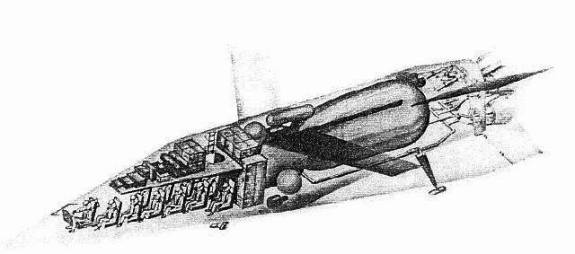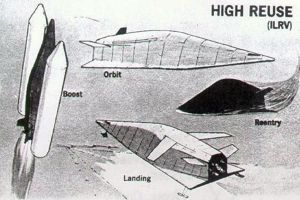
Home - Search - Browse - Alphabetic Index: 0- 1- 2- 3- 4- 5- 6- 7- 8- 9
A- B- C- D- E- F- G- H- I- J- K- L- M- N- O- P- Q- R- S- T- U- V- W- X- Y- Z
McDonnell-Douglas ILRV

McD-D ILRV
McDonnell-Douglas ILRV
Credit: NASA
Status: Design 1968. Payload: 22,680 kg (50,000 lb). Thrust: 16,240.00 kN (3,650,890 lbf). Gross mass: 1,324,489 kg (2,919,998 lb). Diameter: 61.90 m (203.00 ft). Apogee: 550 km (340 mi).
The 1966 Aeronautics and Astronautics Coordinating Board (AACB) report had concluded that "no single, most desirable vehicle concept could be identified…for satisfying future DoD and NASA objectives." So the search for a viable concept continued. In 1967-68, the US Air Force issued a number of study contracts for "Integral Launch and Re-entry Vehicles" (ILRVs). This configuration consisted of a reusable single-stage VTHL RLV with expendable propellant tanks to reduce the weight, size and development cost of the spaceplane.
AACB and other previous studies had indicated that fully reusable "Class II" launch vehicles would have to be TSTOs since they would weigh too much at lift-off. But the need to develop two separate vehicles also greatly increased the DDTandE cost. "Class I" DynaSoar-like reusable mini-spaceplanes, on the other hand, would have a high recurring cost per flight since they would be launched on existing expendable launchers. The ILRV represented the best of both worlds since all the expensive components (engines, avionics, power and life support systems etc.) would be recovered and reused while only the relatively inexpensive propellant tanks would be discarded. The cost per launch would thus be lower than for "Class I" while the development cost would less than for the "Class II" TSTOs.
By this time (1968), the RLV plans had grown increasingly cautious and the ILRV was actually regarded as the most advanced of three manned spaceflight options, the others being a standard Apollo capsule and a new reusable lifting-body spacecraft plus existing or new expendable launchers. The McDonnell-Douglas ILRV design featured fold-out wings for improved low-speed lift-to-drag ratio during final descent and landing. All of the vehicle's propellants were moved outside the orbiter into two large hydrogen tanks and two smaller oxygen tanks. The original concept was sized for an 11,340kg, 9.44m x 4.57m payload. The gross lift-off weight would have been 1670.58t and the ILRV would have been powered by five 3911.55-KN thrust high chamber pressure engines. The final version, from late 1968, was scaled up to a payload capability of 22.68t and then submitted to NASA along with McDonnell-Douglas' other Space Shuttle proposals. Development cost: $4.2 billion (1969 dollars == $19B at 1999 economic conditions).
LEO Payload: 22,680 kg (50,000 lb) to a 550 km orbit at 55.00 degrees.
Family: orbital launch vehicle, Winged. Country: USA. Agency: Douglas. Bibliography: 44, 509.
 | McD-D ILRV McDonnell-Douglas ILRV Credit: NASA |
Back to top of page
Home - Search - Browse - Alphabetic Index: 0- 1- 2- 3- 4- 5- 6- 7- 8- 9
A- B- C- D- E- F- G- H- I- J- K- L- M- N- O- P- Q- R- S- T- U- V- W- X- Y- Z
© 1997-2019 Mark Wade - Contact
© / Conditions for Use